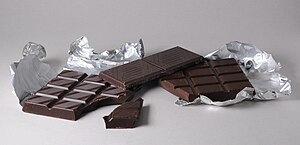bitter chocolate
Dark chocolate is chocolate with a high cocoa content . Other names are semi-dry, dark chocolate , dark chocolate , dark or black chocolate .
This type of chocolate tastes slightly bitter and is darker and usually less sweet than milk chocolate and - in contrast to milk chocolate - is usually made without milk or, more rarely, with only a small amount of milk. The cocoa content is significantly higher than in other types and therefore usually also the fat content. The higher the cocoa content in the dark chocolate, the tart and less sweet the taste.
ingredients
For chocolate with the designations "semi-bitter" or "dark bitter" and "bitter" - with the exception of dark cream chocolate - there must be a cocoa content of at least 50 or 60%. The designation dark chocolate is not specified in food law; However, chocolate must contain at least 35% total cocoa solids, of which at least 18% cocoa butter and at least 14% fat-free cocoa solids. Chocolates with a cocoa content of 100% are available in stores, which means that they contain no other ingredients apart from cocoa mass and possibly cocoa butter.
Due to the lack of or low milk content, most dark chocolates are completely or almost completely lactose-free and therefore better tolerated by lactose-intolerant people than milk chocolate.
During investigations at the University Clinic in Kiel, traces of the mold toxin ochratoxin A were found in all samples of dark chocolate examined .
Gender specific marketing
The term men's chocolate for dark chocolate is a marketing term . Since the 19th century, chocolate has been perceived primarily as a product for children and women, which is why the tart, dark variant is also marketed as men's chocolate .
Until the 19th century, chocolate was a luxury drink for adults in Europe . It was considered nourishing and invigorating, and in some cases also an aphrodisiac . The image change from chocolate to confectionery led to a marketing offensive by manufacturers. The term men's chocolate was introduced at the end of the 19th century, probably first by Stollwerck . As early as the 1870s, however, the Chocolat Suchard company in Switzerland was producing cocoa powder as drinking chocolate for the army under the name “military chocolate ”. Around 1900 chocolate was part of the emergency ration of various European armies. and even in World War II , bitter chocolate with added caffeine was used as aviator chocolate as part of the Air Force catering.
Health effects
Some studies have concluded that eating dark chocolate because of its high content of flavonoids like epicatechin the cardiovascular system protects. In addition, consuming dark chocolate lowers blood pressure.
According to an American study carried out on 2291 pregnant women from 1996 to 2000, the consumption of dark chocolate can reduce the risk of preeclampsia in pregnant women. The number of women with corresponding symptoms was directly negatively dependent on the level of the alkaloid theobromine contained in the chocolate in the serum.
According to an investigation by the journal Ökotest , certain dark chocolates can have high levels of cadmium , which can damage the bones or the nervous system and possibly lead to cancer.
Web links
- Live longer with dark chocolate . In: Telepolis . 4th July 2007.
Individual evidence
- ↑ Entry on chocolate products. In: Römpp Online . Georg Thieme Verlag, accessed on November 26, 2013.
- ^ Text of the cocoa regulation
- ↑ Bitter Chocolate at Laktonaut.de
- ↑ M. Kreutzfeldt, H. Gersmann: Examples of contaminated food - poison in chocolate . In: taz . October 19, 2009.
- ↑ Monika Setzwein: Diet - Body - Gender: on the social construction of gender in a culinary context . VS, Verlag für Sozialwiss., Wiesbaden 2004, ISBN 3-8100-4122-X , p. 183 (Zugl .: Kiel, Univ., Diss., 2003).
- ^ Roman Rossfeld: From women's drink to military emergency ration. Chocolate consumption from a gender perspective . In: Bern journal for history and local history . tape 63 , no. 1 , 2001, ISSN 0005-9420 , p. 55–68 ( bezg.ch [PDF]).
- ↑ Roman Sandgruber : Ladies Chocolate . In: Upper Austrian news . October 13, 2007, p. 38 ( website 1248 in the forum OoeGeschichte.at).
- ↑ MB Engler, MM Engler, CY Chen, MJ Malloy, A. Browne, EY Chiu, HK Kwak, P. Milbury, SM Paul, J. Blumberg, ML Mietus-Snyder: Flavonoid-rich dark chocolate improves endothelial function and increases plasma epicatechin concentrations in healthy adults. In: J Am Coll Nutr. 23 (3), Jun 2004, pp. 197-204. PMID 15190043
- ↑ Davide Grassi, Cristina Lippi, Stefano Necozione, Giovambattista Desideri, Claudio Ferri: Short-term administration of dark chocolate is followed by a significant increase in insulin sensitivity and a decrease in blood pressure in healthy persons . In: American Journal of Clinical Nutrition . tape 81 , no. 3 , 2005, ISSN 0002-9165 , p. 611-614 ( ajcn.org ).
- ↑ Information Group Oral Hygiene and Eating Behavior, Press Service No. 06, June 2008.
- ↑ EW Triche, LM Grosso, K. Belanger, AS Darefsky, NL Benowitz, MB Bracken: Chocolate Consumption in Pregnancy and Reduced likelihood of preeclampsia . In: Epidemiology. Volume 19, No. 3, May 2008, pp. 459-464. doi: 10.1097 / EDE.0b013e31816a1d17
- ↑ Chocolate, dark chocolate: here you go! (No longer available online.) In: Öko-Test . Archived from the original on January 4, 2011 ; Retrieved March 9, 2012 .
